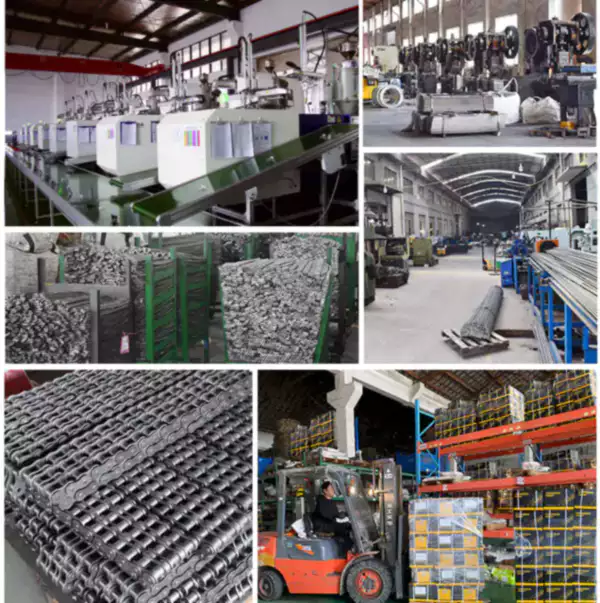Gripper chains are an essential component in many manufacturing processes as they are used to move products along assembly lines. However, like any other machinery, they are prone to wear and tear, and this can cause several issues during the production process. In this article, we will discuss some of the common issues with gripper chains and how to troubleshoot them.
1. Chain Skipping
Chain skipping can occur when the chain fails to engage with the sprocket, causing intermittent movement of the product. Some of the common causes of chain skipping include worn chain links, misaligned sprockets, and insufficient chain tension. To troubleshoot the issue, the sprockets and the chain should be inspected for wear and proper alignment. The chain tension should also be adjusted to the manufacturer's recommended guidelines.

2. Chain Jamming
Chain jamming is a common issue that can cause a complete shutdown of the production line. This issue occurs when the chain links get caught between the sprocket teeth, causing the chain to stop moving. Chain jamming can be caused by several factors, including dirt and debris on the chain, worn sprocket teeth, and chain tension issues. To troubleshoot this issue, the chain should be inspected for dirt and debris, and the sprockets should be examined for wear. The chain tension should also be adjusted to prevent jamming.

3. Chain Elongation
Chain elongation occurs when the chain links stretch beyond their recommended limit, causing the chain to become loose. This issue can be caused by several factors, including improper chain tension, worn sprockets, and lack of lubrication. To troubleshoot this issue, the chain should be inspected for wear, and the sprockets should be examined for signs of wear. The chain tension should also be adjusted to the manufacturer's recommended guidelines, and the chain should be lubricated regularly.

4. Chain Breakage
Chain breakage can occur due to several factors, including worn chain links, excessive chain tension, and damaged sprockets. This issue can cause significant downtime and can result in costly repairs. To troubleshoot this issue, the chain should be inspected for wear and damage, and the sprockets should be examined for signs of wear. Chain tension should also be adjusted to the manufacturer's recommended guidelines.
5. Uneven Chain Wear
Uneven chain wear can occur when the chain is not properly aligned or when the sprockets are not properly aligned. This issue can cause premature wear of the chain and the sprockets, leading to costly repairs. To troubleshoot this issue, the chain and the sprockets should be inspected for proper alignment. If misalignment is detected, adjustments should be made to the machine to ensure proper alignment.
Gripper Chains Purchasing Guide
| Parameter | Recommendation |
|---|---|
| Chain pitch | Match machine manufacturer's specifications |
| Chain length | Match machine manufacturer's specifications |
| Chain material | Select material that is suitable for the application |
| Chain type | Select the appropriate chain type for the application |
| Chain tensile strength | Select the appropriate tensile strength for the application |
| Warranty | Ensure that the manufacturer offers a warranty for the product |
Sprockets for Gripper Chains
Gripper chains and sprockets are complementary products that work together in assembly line applications. Sprockets are used to drive the chain and maintain proper tension, while the chain is used to move the products along the assembly line. At Everpower, we offer a complete line of sprockets that are compatible with our gripper chains. Our sprockets are made from high-quality materials and are designed to meet or exceed OEM specifications.

Our sprockets are available in a variety of sizes and tooth configurations to meet the needs of any application. We also offer custom sprockets that are designed to meet the unique needs of our customers.
Our Advantages
- We are a leading manufacturer of gripper chains and sprockets
- We offer a wide range of products to meet the needs of any application
- Our products are made from high-quality materials and are designed to meet or exceed OEM specifications
- We offer competitive pricing and fast delivery times
- We have a dedicated team of engineers and technical support staff to assist with any questions or issues

Q&A
Q: How often should I lubricate my gripper chain?
A: The frequency of lubrication depends on several factors, including the application, the environment, and the type of chain. As a general rule, the chain should be lubricated after every 8 hours of use or as recommended by the manufacturer.
Q: Can I use a different brand of sprocket with my Everpower gripper chain?
A: While it is possible to use a different brand of sprocket with our gripper chain, we recommend using our sprockets to ensure proper compatibility and optimal performance.
Q: How do I determine the correct chain pitch for my application?
A: The correct chain pitch is determined by the machine manufacturer's specifications. If you are unsure of the correct chain pitch, please consult with our technical support team for assistance.
Edited by Zqq.
